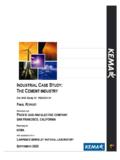Transcription of SDG&E Cannabis Ag Energy Demand Final Report 071516
1 May 1, 2015 SDG&E Cannabis Agriculture Energy Demand Study Final Report Prepared for San Diego Gas & Electric Company Submitted by Evergreen Economics CALMAC ID: July 15, 2016 Evergreen Economics Page i Table of Contents 1 EXECUTIVE SUMMARY .. 1 2 INTRODUCTION .. 3 RESEARCH OBJECTIVES .. 3 DATA COLLECTION AND ANALYSIS METHODS .. 4 3 LITERATURE REVIEW .. 7 LEGALIZATION OVERVIEW .. 7 GROWING TECHNIQUES AND PREFERENCES .. 8 Energy USAGE IN GROWING OPERATIONS.
2 9 UTILITY INTERVENTION STRATEGIES .. 11 COMMUNITY IMPACTS .. 12 IMPLICATIONS FOR CALIFORNIA .. 13 4 UTILITY IN-DEPTH INTERVIEWS .. 15 Energy USAGE IN GROWING OPERATIONS .. 15 Energy Impacts .. 15 Energy Using Equipment .. 17 UTILITY INTERVENTION STRATEGIES .. 18 COMMUNITY IMPACTS .. 20 5 TRADE ORGANIZATION IN-DEPTH INTERVIEWS .. 21 Energy USAGE IN GROWING OPERATIONS .. 21 Energy Impacts .. 21 Energy Using Equipment .. 22 Cannabis GROWER CHARACTERISTICS AND PREFERENCES.
3 23 LEGISLATIVE BARRIERS .. 24 OTHER Cannabis INDUSTRY OPERATIONS .. 25 UTILITY INTERVENTION STRATEGIES .. 25 COMMUNITY IMPACTS .. 26 6 FINDINGS AND RECOMMENDATIONS .. 28 7 APPENDIX A LITERATURE REVIEW SOURCES .. 32 Evergreen Economics Page 1 1 Executive Summary Evergreen Economics conducted research for San Diego Gas & Electric Company (SDG&E) to inform its Business Plan development. Research Objectives and Approach This research addresses questions relating to the Cannabis industry, its Energy use, possible intervention strategies, and the implications for legalization of recreational production and use in SDG&E s service territory.
4 The research was conducted in June of 2016 and included three components: Literature review; In-depth interviews with utilities in states where recreational Cannabis is legal (Washington, Oregon and Colorado); and In-depth interviews with trade organizations that work with the Cannabis industry in states where recreational and/or medical Cannabis is legal. Summary of Results Almost all utilities Evergreen spoke with have seen an increase in Energy Demand due to the legalization of recreational Cannabis in their state and the subsequent increase in growing operations.
5 Electricity costs comprise between 20 and 50 percent of growers operational costs. Sixty percent of this cost is estimated to be due to Demand charges for time of use rates. Lighting is the biggest source of Energy consumption, particularly in indoor and greenhouse operations. While some Cannabis growers have chosen to install LEDs, there remains a preference for T5s due to the impression among growers that the Cannabis yield with LEDs is lower (although this is not a universal belief), that LEDs are bulky, and because the upfront cost of LEDs is prohibitory, especially given all the other startup costs associated with building a new indoor grow facility.
6 There are many benefits associated with indoor growing, but these benefits come at the expense of increased Energy usage compared to greenhouse and outdoor growing. This Report focuses on indoor and greenhouse growing, as these facilities are most likely to have an impact on the grid. Greenhouses offer a middle ground between the greater environmental control of indoor grow operations and the lower Energy Demand of outdoor operations. Utilization of natural light causes the load shape of greenhouses to vary significantly from the load shape associated with indoor growing, where the load is constant and more predictable.
7 Some growers in other states have utilized solar to offset their Energy intensive growing practices. Evergreen Economics Page 2 The potential exists for utility interventions other than lighting including air conditioning systems, controls and conversion to drip irrigation. A few utilities have taken tailored approaches to these industries, with one offering a specific rate and others offering customized incentives. Growers can also take advantage of existing rebate programs. Some utilities hesitate to engage with commercial growers because they do not want to encourage growth in an Energy -intensive market and have concerns about differences in federal, state and local laws.
8 Utilities have had requests for infrastructure upgrades to meet the Demand of new operations. After legalization, utilities reported a slight lag of around six months in the development of growing operations, indicating there is a short window of time between legislative and industry changes for SDG&E to take action. As markets mature, it is possible that growers will shift their focus to keeping operating costs low in order to remain competitive. Cannabis producers may be inclined to work in areas where Energy costs are lower in order to manage their operating costs.
9 Given the industry findings from states that have experienced growth of the Cannabis market after legalization, Evergreen Economics recommends the following: Focus on infrastructure and accommodation as an initial strategy. Engage with Cannabis producers and trade allies as soon as possible in order to influence purchase decisions for new facilities. Customize program literature to the needs of this specific industry. When advising growers on Energy efficient options, take into account local building codes as they relate to indoor Cannabis operations.
10 Monitor local initiatives banning commercial growing that may make it more difficult to control load growth; such bans may lead to widespread residential growing. Monitor equipment choices as the local Cannabis industry develops to gain an understanding of how San Diego s unique climate and drought conditions influence grower choices and Energy usage after legalization. Work with trade organizations to provide information and tools for growers to compare the Energy usage and yield for indoor and greenhouse operations. Consider encouraging integrated solutions that allow facilities to take advantage of wind and solar to help offset increased Demand .



